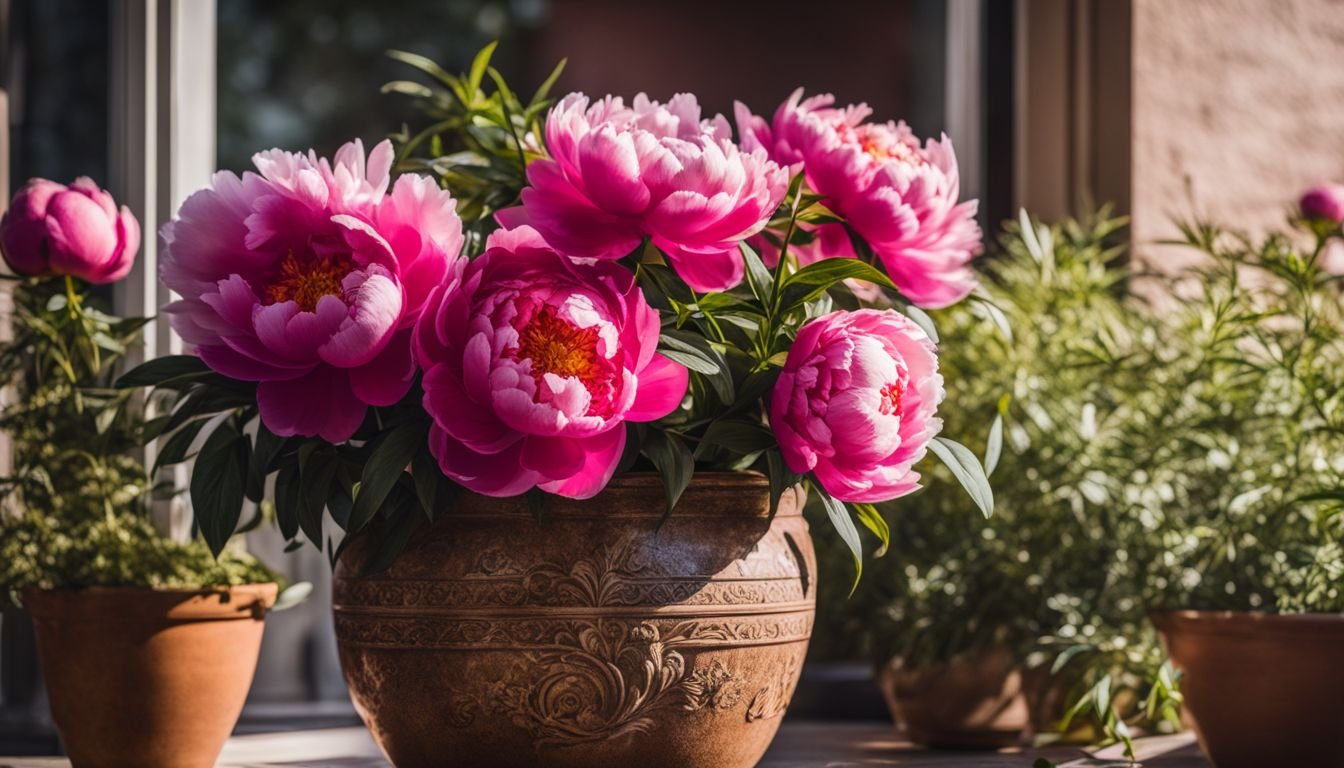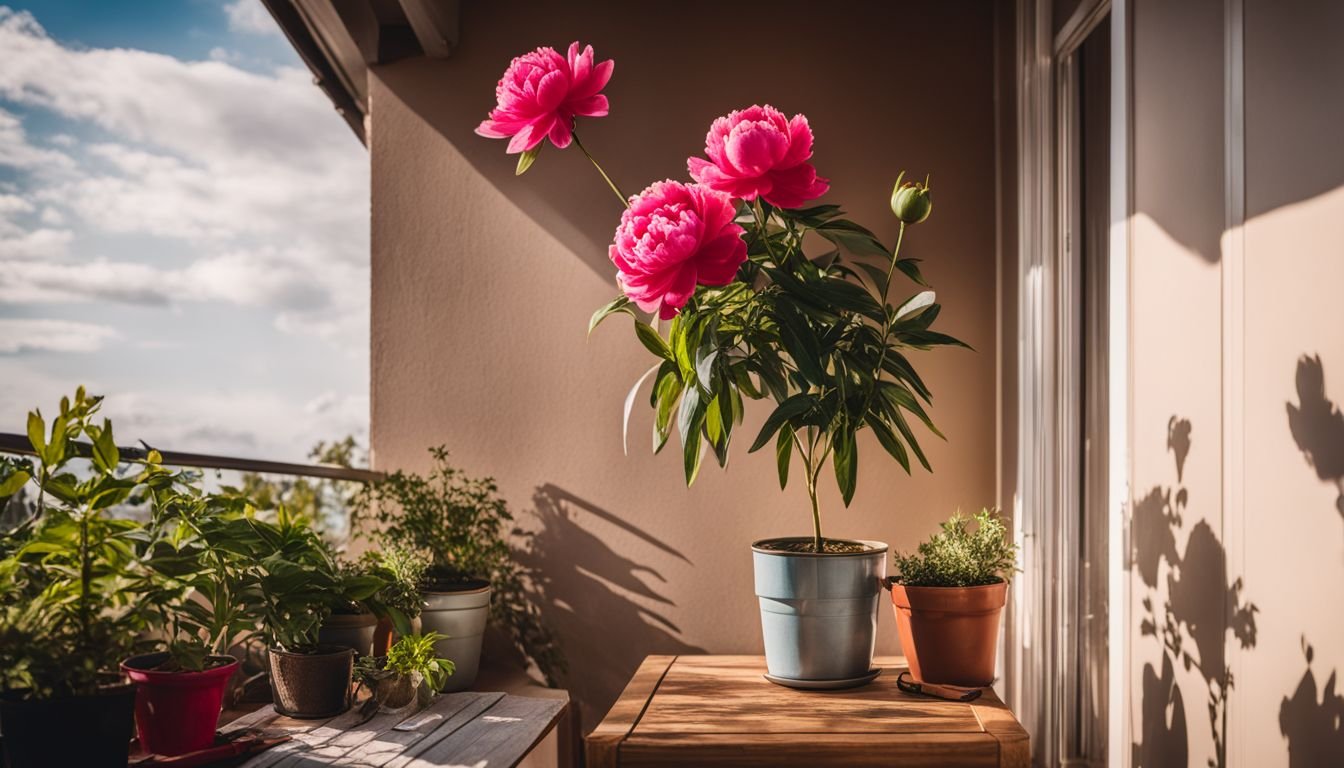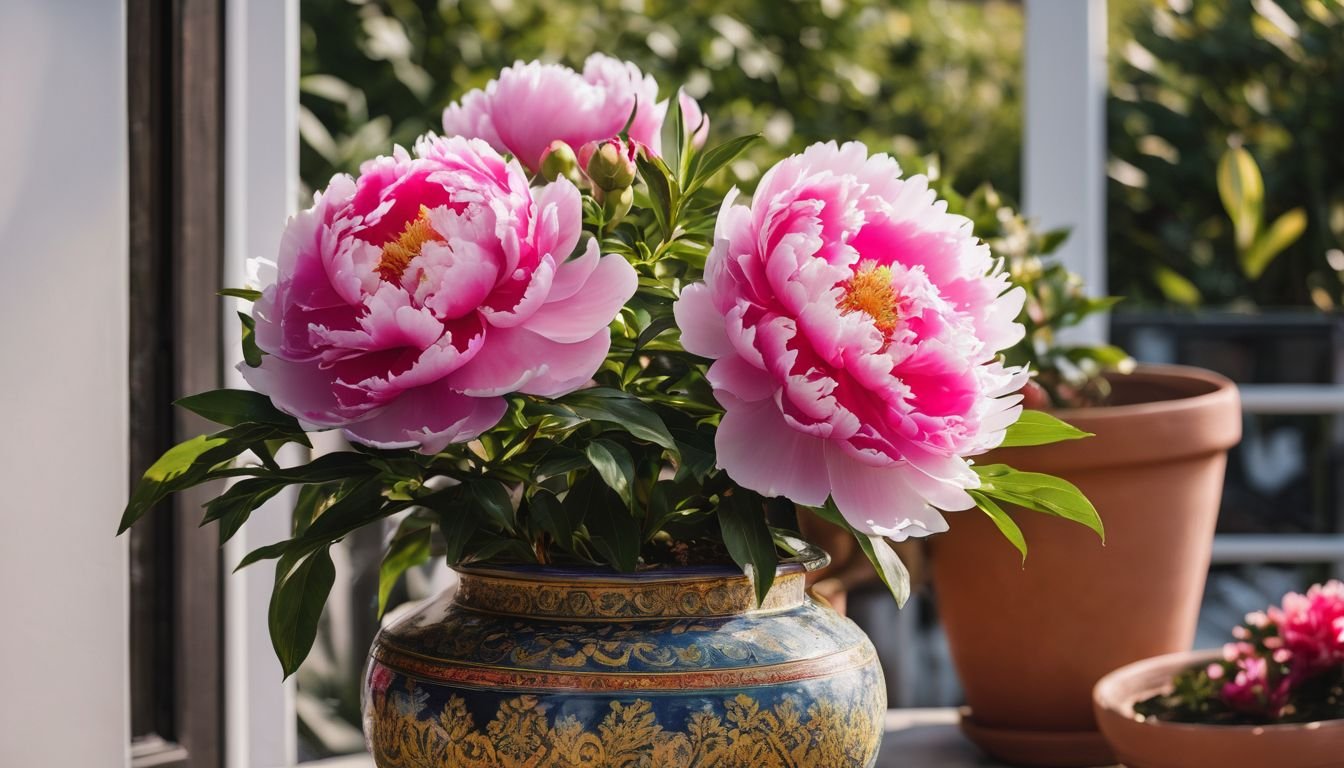Gardeners often face the challenge of limited space, yet yearn for the lush beauty of peonies. These perennials are surprisingly adaptable to container living, thriving under the Australian sun.
Our guide lays out simple steps to cultivate flourishing peonies right in your pot, ensuring even urban green thumbs can enjoy their splendor. Read on and let’s get planting!
Key Takeaways
- Peonies can be successfully grown in pots in Australia, needing at least a 30 cm deep container with proper drainage holes to prevent root rot.
- The best potting mix for peonies combines topsoil with airy materials like perlite, and it’s important to maintain moisture without overwatering, especially during hot summers.
- To protect potted peonies in winter, move them indoors or cover them to avoid damage from frost while keeping soil slightly moist.
- Use a balanced fertiliser after blooming season; high – nitrogen varieties are good for early spring growth support.
- Choose dwarf or semi – dwarf peony varieties that suit Australian climates and consider their mature size to ensure they fit well within the chosen container.
Can Peonies Grow in Pots?

Absolutely, peonies can flourish in containers, offering a versatile option for gardeners with limited ground space. The key to success lies in selecting the appropriate pot size and ensuring it has ample drainage holes to prevent waterlogged roots.
Utilise high-quality potting soil enriched with organic matter like worm castings or well-rotted manure to boost fertility and support healthy growth.
While these stunning blossoms typically bask in full sun locations, container-grown peonies benefit from some afternoon shade—especially during Australia’s hot summers—to extend their blooming period.
Ensure pots are large enough to accommodate the peony’s woody root system without crowding, generally opting for at least 30 cm deep to mimic their preferred growing conditions in a perennial garden setting.
Regular monitoring for pests like aphids is also essential; they can be dispatched effectively with insecticidal soap sprays if needed.
How to Grow Peonies in a Container: Step-by-step Guide

Embarking on the journey of cultivating peonies in pots can be deeply rewarding, and with our step-by-step guide tailored for Australian gardeners, you’ll have all the know-how to ensure these stunning blooms flourish.
From pot selection to planting techniques, we provide a clear path for creating your own vibrant peony display, even in limited spaces.
Choosing the right pot
Selecting an ideal pot for your peony is crucial to its growth and blooming success. Aim for a container that matches or exceeds the minimum dimensions of 1 ½ feet deep and equally as wide, ensuring your peony has enough room to develop its root system.
Crucially, the pot must have adequate drainage holes to prevent water from pooling at the bottom, which can lead to root rot. This attention to space allows the roots to spread out and provide a sturdy base for those lush blooms.
Choose pots made of materials like terracotta or wood which offer breathability and help regulate soil temperature. Such materials are particularly beneficial during Australia’s unpredictable weather patterns, where temperatures can soar and drop unexpectedly.
Providing ample room in a quality container not only ensures good health but also encourages your potted peonies to produce those spectacular blossoms gardeners adore.
Selecting the ideal soil type
Peonies thrive in a soil blend that’s light, drains well, and is rich in nutrients. Mix up your own potting compost with 65% topsoil to give it structure and the rest should be airy materials like perlite or peat-free compost.
This balance ensures roots get enough air and water without sitting in moisture too long which could cause rot.
For these beautiful blooms, consider creating raised beds within the container using organic mulch around the plant base after planting. It keeps moisture levels steady while adding extra nourishment as it breaks down over time.
Remember, loose and fertile are keywords for peony success; avoid heavy clay soil that can lead to waterlogged roots damaging your prized peonies.
Correct planting method
To ensure your peonies thrive in a pot, start by digging a hole that’s roughly 38cm wide and deep. Plant the root with the eyes (or growth buds) facing upwards, no more than 5cm below the soil surface.
This planting depth is crucial as too deep can prevent blooming, while too shallow may expose roots to harsh conditions. Firmly press down the potting mix around the plant to eliminate air pockets which could dry out roots.
Next comes creating an environment for healthy growth by moving on to essential care practices for potted peonies.
Essential Care for Potted Peonies
Mastering the art of peony care in containers ensures these splendid blooms reach their full potential, revealing secrets that can turn even a novice gardener into a peony prodigy.
Regular watering regime
Keeping your potted peonies hydrated is key to their survival, especially through the heat of their first summer. Establish a consistent watering schedule to supply your plants with enough moisture without overdoing it.
Always check that the top inch of soil is dry before giving them a drink, as this will help avoid waterlogging, which can lead to root problems.
Make sure pots have adequate drainage holes and consider mulching after watering to retain soil moisture and fend off those harsh Australian sun rays. During winter months, maintain slightly moist soil while your peonies are stored in a shed or garage, protecting them from extreme freeze-thaw cycles.
Remember, smart watering keeps those stunning peony blossoms coming year after year!
Addressing pests and diseases
While a consistent watering regime lays the foundation for robust potted peonies, safeguarding them from pests and diseases is equally vital. Peonies are mostly resilient but can occasionally fall prey to rot if waterlogged or not cared for correctly.
Vigilant monitoring helps you spot early signs of trouble like blackened stems or wilted leaves, which might indicate peony wilt disease. Immediate action with fungicides specifically designed for such issues can prevent the spread and save your plants.
Maintaining a healthy growing environment is key in preventing problems before they start. Ensure your peony containers have adequate drainage to fend off root rot, and opt for organic fertiliser during the growing season to strengthen their defenses against common ailments.
Strong growth nurtured by proper feeding not only produces stunning blooms but also equips peonies with the resilience to withstand various garden pests and diseases that could otherwise compromise their beauty and longevity.
Using appropriate fertilisers
Fertilising your potted peonies is crucial for their health and beauty. A balanced 10-20-20 fertiliser should be applied around the drip line of the mature plants, giving them the necessary nutrients to thrive.
Make sure to follow this step after your peonies have bloomed; it encourages strong growth and ensures that the next season’s blooms are as stunning as possible.
Carefully measure out the fertiliser, avoiding over-application which can harm more than help your flowers. This simple but vital task supports lush foliage and vibrant blooms in container gardening.
Moving on from nourishment through fertilisation, let’s delve into maintaining peonies during different seasons to keep your floral display looking its best year-round.
Tips for Maintaining Peonies in Different Seasons
5. Tips for Maintaining Peonies in Different Seasons: As seasons shift, so too must your approach to peony care; a tailored strategy ensures these blooms thrive throughout the year in Australia’s unique climate.
Each season presents distinct challenges and opportunities for pot-grown peonies—knowing how to pivot your maintenance routine is key to cultivating healthy, vibrant flowers.
Fall care plan
As the days shorten and temperatures drop, your peonies will start preparing for dormancy. This fall care plan ensures they come back stronger in spring. Start by cutting back the foliage to ground level after the first frost hits; this helps prevent disease and pests from harming the plant over winter.
It’s time to mulch your potted peonies too, providing a thick layer that protects roots against sudden temperature changes.
Make sure pots have adequate drainage because wet soil can lead to tuber rot during cooler months. You might consider relocating containers to a sheltered area which mimics their required heavy frost conditions while shielding them from harsh elements.
Your attention now sets them up for success later – as you move into strategies for overwintering these beauties, remember that a good fall preparation leads to vibrant blooms when warmer weather returns.
Overwintering strategies
Overwintering your potted peonies is crucial for their survival and bloom success in the following season. To get started, move your pots to a sheltered indoor area like a garage or shed before the winter chill hits.
The goal is to shield them from harsh freezes that can damage delicate tubers. Keeping the soil slightly moist prevents it from drying out completely, but take care not to overwater as this could lead to rot.
It’s important to maintain a careful balance during this dormant period – too cold and the roots suffer; too warm and they may wake prematurely. Check on your peonies occasionally throughout winter to ensure they’re in good shape for spring’s arrival.
With these strategies in place, you give your beloved plants the best chance of thriving when they return outdoors after winter’s thaw.
Spring care plan
As spring arrives, your peonies are ready to burst into life. It’s vital to get them off to a strong start with the right care during this crucial growing period. Begin by gradually increasing water as temperatures rise; peonies thrive on consistent moisture but despise soggy feet, so ensure good drainage.
Feed your blooming beauties with a balanced fertiliser to encourage lush growth and impressive flowers. High-nitrogen feeds are perfect for establishing strong stems early in the season.
Pruning plays a key role in springtime care—snip off any dead or weak growth from your potted peonies. This not only tidies up the plant but also directs energy towards producing robust new shoots and larger blooms.
Protect young plants from late frosts by covering them overnight if needed. As they grow, staking might be necessary for herbaceous peonies; support their heavy heads and prevent damage from winds or rain-induced flopping.
Be vigilant about pests and diseases; regular checks help catch issues early before they can affect the health of your plant or compromise its performance come bloom time.
Choosing the Right Peony Varieties for Pot Cultivation
Select peony varieties that are known for their compact growth habits, as these will flourish within the confines of a pot. Dwarf or semi-dwarf types like ‘Coral Charm’ with its captivating salmon-pink blossoms, or ‘Festiva Maxima’, celebrated for its large white flowers tinged with crimson strokes, are ideal candidates.
Consider their mature size and opt for those that can maintain a proportionate balance with the chosen container. It’s important to identify varieties that align well with Australia’s climate zones; sturdy cultivars such as ‘Sarah Bernhardt’ adapt well to Australian conditions and bring forth plush pink petals season after season.
Ensure you’re planting peonies that can handle Australia’s specific environmental challenges, especially if living in areas prone to drought. Look into species like Paeonia lactiflora hybrids which offer not only spectacular blooms but also inherent drought tolerance once established—a must-have trait for successful pot cultivation in certain Aussie locales.
Peony roots crave room to expand and breathe; hence, root confinement isn’t an issue when selecting potted plants wisely: shorter root systems are your ally here. Prioritise these key traits while choosing your peonies—compact growth habit, suitability for zone 8 climates where required, robustness against local pests—and delight in their vibrant displays from a comfortably sized pot on your patio or balcony.
Related Blooms: Exploring the Protea Flower (link to protea flower article)
As you delve into the world of peonies, don’t miss out on the opportunity to discover another remarkable bloom – the Protea flower. This striking plant is renowned for its large, colourful bracts and long vase life, making it a prized choice for both gardeners and florists alike.
Native to South Africa but adaptable in various climates including zone 8 areas, proteas offer an exotic touch to any horticultural endeavour or bouquet.
Cultivating proteas requires attention to detail as they thrive in well-drained soil and are drought tolerant once established. Garden enthusiasts seeking a challenge will appreciate their unique beauty amidst other plants.
Their resilience against harsh conditions makes them an excellent companion for Peonies in gardens facing water restrictions or dry seasons. Dive into our linked article about the Protea flower where we explore techniques for growing these captivating plants that add diversity and intrigue to your gardening projects.
Conclusion
Embrace the joy of potting peonies and watch your Australian garden flourish with vibrant hues and lush blossoms. With the right container, soil mixture, and care regimen, these floral treasures will thrive.
Remember to protect them from harsh winter chills and relish their blooming splendor when spring dances into your space. Your dedication to nurturing these potted beauties promises a reward of delightful blooms year after year.
Enjoy the journey of growing peonies in pots – it’s a garden adventure worth every moment!
FAQs
1. Can I grow peonies in a pot if I live in Australia?
Yes, you can grow peonies in pots in Australia with the right care and conditions. Make sure to choose a spot that provides ample sunlight and protection from harsh weather.
2. What kind of pot should I use for cultivating peonies?
Choose a large, sturdy pot with adequate drainage holes to ensure your peony plant has enough room for its roots to spread and access to water without being waterlogged.
3. How often do potted peonies need watering in Australian climates?
Water your potted peonies deeply but infrequently, allowing the soil to dry out slightly between waterings; this is especially important during the hot Australian summer months.
4. Do peonies grown in pots require special fertiliser or soil?
It’s best to use well-draining soil mixed with compost or horticulture-specific fertiliser designed for flowering plants like peonies, ensuring they receive the nutrients needed for vibrant blooms.
